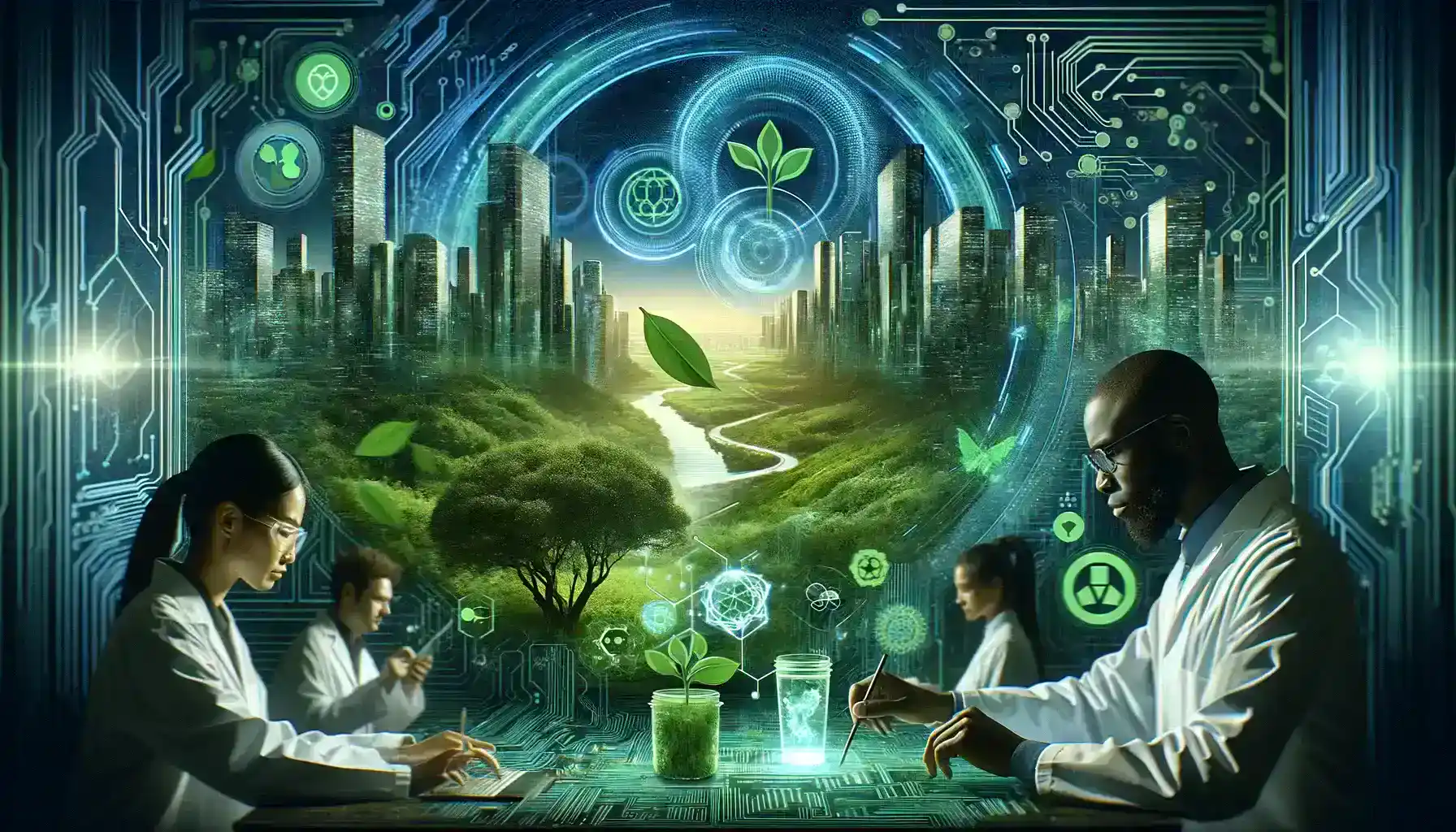Table of Contents
In a world grappling with the profound challenges of climate change, the fusion of technology and innovation has emerged as a beacon of hope on the horizon. As we grapple with the pressing need to reduce carbon emissions and combat the far-reaching effects of climate change, the role of technology in shaping a sustainable future has become more pivotal than ever before.
This article embarks on a captivating journey into the world of “Tech for Good,” exploring the dynamic synergy between artificial intelligence (AI) and eco-innovation as formidable allies in our quest for carbon reduction. Through real-world examples and insights, we unravel the remarkable ways in which cutting-edge technology is catalyzing positive change, ushering in an era of environmental stewardship and sustainable progress. Join us as we delve into the transformative potential of eco-innovation with AI, where innovation meets eco-consciousness, and where technology becomes the driving force behind a greener, more promising tomorrow.

Smart Grids for Efficient Energy Management
Smart grids represent a cutting-edge solution in the quest for more efficient energy management and carbon reduction. These advanced systems leverage AI algorithms to create intelligent energy distribution networks that bring about multiple benefits.
In Copenhagen, Denmark, the implementation of smart grids has been a remarkable success story. By harnessing AI’s capabilities to balance energy supply and demand in real time, the city has achieved a substantial reduction in carbon emissions. Copenhagen’s smart grids optimize the use of renewable energy sources, such as wind and solar power, while minimizing waste in the energy distribution process.
This not only contributes to a greener and more sustainable environment but also ensures a reliable and stable energy supply for the city’s residents. Smart grids are a prime example of how eco-innovation with AI can create a win-win situation, simultaneously addressing climate change concerns and enhancing the overall quality of life for the community.
Precision Agriculture and Eco-Innovation With AI
AI-powered precision agriculture represents a groundbreaking innovation in the realm of farming, offering a new frontier in sustainable and efficient food production. The convergence of eco-innovation with AI technologies is reshaping the agricultural landscape in ways that not only enhance productivity but also significantly contribute to carbon reduction efforts.
At the heart of this eco-innovation with AI transformation is the use of advanced tools such as drones, sensors, and machine learning algorithms. These technologies provide farmers with an unprecedented level of insight into their operations, enabling them to make data-driven decisions that optimize resource utilization, reduce waste, and minimize environmental impact.
A standout pinnacle of this revolution is John Deere’s AI-driven tractors. These agricultural machines are equipped with real-time data-gathering capabilities that monitor various factors, including soil conditions, crop health, and weather patterns. By continuously analyzing this data through AI algorithms, farmers gain precise insights into their fields’ conditions and can fine-tune their farming practices accordingly.
Furthermore, Eco-Innovation With AI precision agriculture enhances crop yields through better pest and disease management and targeted nutrient application. This increased productivity can potentially reduce the need for expanding farmland into natural habitats, further curbing carbon emissions associated with deforestation and land-use changes.
Climate Modeling and Predictive Analytics

Climate Modeling and Predictive Analytics are crucial tools in our efforts to combat the complex challenges of climate change. Climate modeling involves the use of computer simulations to replicate and analyze various climate processes, enabling scientists to make predictions about future climate scenarios. However, traditional climate models often face computational limitations and can be less precise.
In recent years, the integration of artificial intelligence (AI) and machine learning has revolutionized climate modeling, significantly enhancing its accuracy and predictive capabilities. These technologies empower researchers to make more informed decisions and take proactive steps in mitigating the effects of climate change.
For example, Google’s DeepMind has leveraged AI to predict energy consumption within its data centers. By analyzing historical data and factoring in variables like weather conditions and user demand, AI algorithms provide real-time recommendations for optimizing cooling systems. This innovative approach has led to a substantial 40% reduction in energy usage, making a meaningful contribution to carbon reduction and environmental sustainability.
The synergy between Eco-Innovation With AI, Climate Modeling, and Predictive Analytics exemplifies the transformative potential of technology in addressing our planet’s pressing challenges.
Eco-Friendly Transportation with AI
Eco-Innovation with AI is revolutionizing the transportation sector, offering a promising path toward a more sustainable future. Companies at the forefront of this transformation, such as Tesla and Waymo, are leveraging AI’s power to reshape the way we think about transportation.
Tesla’s electric vehicles equipped with AI-powered Autopilot systems have gained immense popularity. These vehicles not only eliminate tailpipe emissions but also incorporate AI technology to navigate efficiently. Through advanced sensors and machine learning algorithms, Tesla cars can anticipate traffic patterns, optimize driving routes, and reduce energy consumption. This combination of electric propulsion and AI-driven efficiency has significantly decreased the carbon footprint of traditional combustion engine cars.
Similarly, companies like Waymo are developing autonomous electric vehicles that promise to further reduce emissions. By removing human error from driving, autonomous vehicles can operate with unparalleled precision and safety, leading to smoother traffic flows and reduced fuel consumption.
Moreover, ride-sharing platforms like Uber and Lyft have embraced AI algorithms to optimize transportation routes. Through real-time data analysis, these services can match riders and drivers more efficiently, minimizing empty vehicle miles and reducing emissions associated with idle cars.
AI-Enhanced Recycling and Waste Management
Effective waste management is a pivotal component of any sustainable ecosystem, and the integration of artificial intelligence (AI) has ushered in a new era of innovation in recycling and waste management. With a focus on “Eco-Innovation with AI,” let’s explore how these advancements are reshaping our approach to handling waste.
One of the standout developments in this field is the utilization of AI-driven waste sorting robots, exemplified by companies like ZenRobotics. These sophisticated machines are equipped with advanced sensors and computer vision technology that allows them to identify and separate recyclables from mixed waste streams with remarkable precision. By employing machine learning algorithms, they continuously improve their sorting capabilities, ensuring an increasingly accurate separation of materials.
Companies like CleanRobotics have taken this innovation a step further with solutions like the “TrashBot.” By combining computer vision and AI, TrashBot excels in the efficient sorting of recyclables from mixed waste. This promotes recycling, conserves valuable resources, and further diminishes the environmental footprint associated with waste management.

AI-Powered Environmental Monitoring
AI-Powered Environmental Monitoring is a revolutionary approach that combines the capabilities of artificial intelligence (AI) and unmanned aerial vehicles, such as drones, to enhance our understanding of environmental changes and support conservation efforts. In the context of Eco-Innovation with AI, this innovative approach is transforming the way we monitor and protect fragile ecosystems.
Conservation Drones: AI-equipped drones are being employed for environmental monitoring and conservation. These drones can collect data on deforestation, pollution, and wildlife populations, allowing for more informed eco-policies and conservation efforts. Organizations like Conservation International have successfully used AI to protect fragile ecosystems.
Climate Modeling and Prediction
Climate and increasing environmental challenges, advanced climate modeling, and prediction have become indispensable tools for understanding and addressing the impacts of climate change. As our world grapples with more frequent and severe weather events, such as hurricanes, droughts, and heatwaves, the need for precise and timely forecasts has never been greater. This article explores the innovative realm of climate modeling and prediction, particularly focusing on IBM’s groundbreaking Global High-Resolution Atmospheric Forecasting System (GRAF). With a key emphasis on “Eco-Innovation With AI,” we’ll delve into how AI-driven advancements are reshaping our ability to predict and respond to weather patterns, climate change, and their broader environmental implications.
IBM’s Weather Forecasting: Enhancing Climate Modeling and Prediction
Advanced climate modeling, fueled by the integration of artificial intelligence (AI) Eco-Innovation With AI, stands at the forefront of our efforts to better comprehend and mitigate the consequences of climate change. IBM’s Global High-Resolution Atmospheric Forecasting System, aptly known as GRAF, epitomizes the synergy between AI and eco-innovation, offering unprecedented insights into weather patterns and climate variability.
At the core of GRAF’s capabilities lies its ability to provide high-resolution weather forecasts on a global scale, significantly improving the granularity and accuracy of predictions. By employing AI algorithms and processing vast amounts of real-time data, GRAF can simulate atmospheric conditions with exceptional precision, enabling meteorologists and climate scientists to make more informed and timely forecasts.
Conclusion
The examples presented in this article serve as a compelling testament to the remarkable synergy between eco-innovation with AI, showcasing their pivotal role in the global endeavor to reduce carbon emissions and combat climate change. Through innovative applications, these technologies are transforming industries and reshaping the way we approach environmental sustainability.
From optimizing energy grids to revolutionizing agriculture and transportation, AI-driven solutions are driving significant progress in carbon reduction efforts. Smart grids harness AI’s analytical capabilities to enhance energy distribution and reduce waste, making our energy systems more efficient and eco-friendly. AI-powered tractors in agriculture maximize resource utilization while minimizing environmental impact, and electric vehicles equipped with AI contribute to cleaner transportation options.
As we reflect on these achievements, it becomes evident that the path to a greener, more eco-conscious world is within our reach. By nurturing a commitment to eco-innovation with AI at its core, we open doors to a future where sustainable practices are not just a choice but a way of life.
The potential for technology, when harnessed for good, to serve as a driving force in creating a sustainable future for generations to come is both inspiring and motivating. Embracing eco-innovation with AI as a guiding principle, we embark on a journey where our actions today will leave a lasting positive impact on the environment and society. The vision of a harmonious coexistence between humanity and nature is no longer a distant dream but an achievable reality, where “Eco-Innovation With AI” emerges as a beacon of hope in our mission to safeguard the planet.





